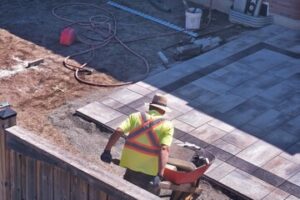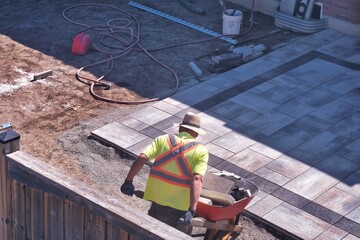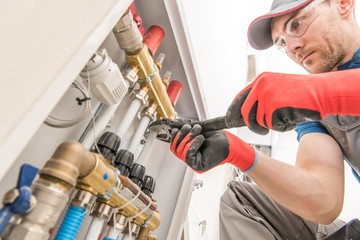Patio Construction Richmond VA is often a large project. Budget and taste are important factors when choosing your material. Other considerations include durability, heat retention and relative tolerance to freeze-thaw cycles.
After marking the site for your patio, builders excavate the footprint and tamp down the soil. They install a base of gravel and a layer of coarse sand to set pavers on.
Concrete patios offer an affordable option for those seeking a durable and functional outdoor space. They’re suitable for many different styles of home architecture and are available in a wide range of colors and textures to complement any backyard aesthetic. While they are not as flexible as pavers, a concrete patio is highly durable and can withstand heavy loads. When choosing a contractor for a concrete patio installation, it’s important to ensure that they have experience with this material and will be able to construct the slab to the owner’s specifications.
When building a concrete patio, it’s critical to follow local building codes and avoid working around buried utilities and other sensitive areas. A permit may be required and a survey of the yard to locate septic tanks or other underground lines. It’s also a good idea to check with your city planning department to see if there are any additional requirements for your property.
Before beginning a concrete patio construction project, it’s important to gather the necessary materials. A wheelbarrow, shovel, rake, mason’s trowel and a concrete mixer are essential tools for this type of project. Other supplies include lumber for forms and wooden stakes, deck screws and a level. It’s also important to plan ahead and lay out the patio area with string and stakes before digging. This will give you a better picture of how the finished patio will look in your backyard and allow you to adjust the layout if needed.
Pouring the concrete is a simple process, but it requires patience. Once the concrete is mixed, it’s poured into the form and compacted into corners using a square shovel or mortar hoe. A contractor then smoothes the surface with a bull float and fills low spots. Once the surface is finished, it needs to sit for a few hours until it’s completely dry.
Once the concrete is cured, it’s ready for surface finishing. Options include a smooth finish, which can be achieved with steel trowels, and a broom finish, which provides a non-slip texture. It’s important to maintain consistent pressure during the finishing process to achieve a uniform appearance. For added color and design, stenciling or engraving techniques can be utilized.
Pavers
Paver patios are popular with homeowners and are available in a wide variety of colors, textures, shapes and sizes. They are durable and easy to maintain, resisting cracking from the freezing/thawing cycles of the soil they rest upon. They also tend to last longer than a slab of concrete due to their flexibility and are often 3 to 4 times stronger than a slab. In addition, pavers can be repositioned or replaced if a piece becomes damaged.
Most people think of pavers when they consider a new backyard patio, however they are also very commonly used for driveways, walkways and other outdoor surfaces. There are different types of pavers, with some made from natural stone and others from concrete. The most common are poured, cement-based pavers. These are manufactured from a combination of gravel, sand, cement and a color dye, then pressed into their shape. They are available in both concrete and brick styles, with some having a more rustic look while others have a more refined finish.
A patio utilizing pavers should begin with a base of crushed rock, usually about 4-inch-deep. This layer should be compacted with a plate compactor. Typically, several passes will be needed to achieve the desired consistency. It’s a good idea to use a fabric landscape membrane over this layer to help lock the soil in place and minimize settling of the base.
Once the base is installed, start laying the pavers. It’s a good idea to lay them out in the design you’ve planned before beginning and to use strings set low to the ground to help keep the blocks straight. Once the design is laid out, the pavers are glued together using a special adhesive called Surebond 20. The adhesive should be applied to the underside of the paver, making sure it doesn’t get on the top or bottom edges of the block.
As with concrete, paver patios require proper maintenance to keep them looking their best. A special sand, known as jointing sand or polymeric sand should be swept into the joints between each paver to prevent weed growth and add strength. This sand isn’t as dense as mortar, so it allows water and air to penetrate, keeping the area strong and weed free. Some homeowners choose to apply a protective sealer to their paver patios, which will make cleanup and protection even easier.
Natural Stone
Natural stone adds elegance and beauty to outdoor spaces that is difficult to replicate with other materials. It can be used to create a wide variety of visual effects that complement any landscape theme. From contemporary sophistication to a warm, organic look, natural stone allows you to design a unique patio that will reflect your personality and complement your home.
Unlike other patio paving materials, natural stone is not susceptible to the same types of damage from weather and wear and tear. When properly installed, it will last for decades without requiring repairs or replacements. In addition, it requires little maintenance to keep its appearance. It is resistant to stains and weathering, and it hardly fades in sunlight.
When selecting the type of natural stone for your project, consider the climate in your region as well as your budget and installation specifications. Some types of stone are brittle and will not hold up to heavy traffic or freeze-thaw cycles. Others, like Pennsylvania Bluestone, are quite durable and a great choice for patios that will see heavy use.
While the initial cost of natural stone is often higher than that of manufactured options, it can add value to your property. It is considered a luxurious material that reflects the beauty of nature and will appeal to prospective buyers.
As for the process of constructing a natural stone patio, it is similar to that of a paver project. Start in one corner of your patio and work inward, laying the stones according to your design. Use a rubber mallet to tap the stone into place and make adjustments as necessary to ensure a level surface. Be sure to leave a consistent gap between each stone that will be filled later on.
After your new stone patio is in place, it can be decorated with decorative edging, borders, or inlays. These accents can highlight areas of interest, add a pop of color, and tie your patio design together. You can also incorporate plants or other hardscaping elements to enhance your outdoor living space. These design elements will help you create a beautiful and unique patio that will impress your friends and family.
Brick
Brick patios are an option that is both durable and versatile. They can be used to create a patio that is simple and easy to maintain or they can be designed in more complex patterns to add a touch of flair. Brick patios are a bit more expensive than concrete, but they offer the ability to create a unique design that will enhance the appearance of any yard.
Before you begin constructing your brick patio, take the time to think about the size and shape that you want it to be. It is important to consider the amount of furniture you plan on placing on the patio and how much space you will need for walking and moving around it. Once you have a clear idea of the shape and size, use spray paint to mark the perimeter.
After you have marked the area, dig a hole that is deep enough to accommodate your chosen bricks and a layer of sand. The hole should slope 1/4-inch per foot for proper drainage. After the excavation is complete, lay down landscaping fabric to prevent weed growth and then spread a layer of gravel that is tamped and compacted with a heavy-grade plate compactor.
Next, apply a 2-inch layer of stone dust with a screed in 5-foot increments. To make the screed, place two pipes five feet apart and parallel to each other. Fill the area between the pipes with stone dust, then scrape away any excess and refill the depressions with the remaining stone dust. The finished surface should be level and smooth.
When laying the bricks, choose one of the classic paving patterns such as basketweave, running bond, or stack bond. These designs look attractive and require little skill to implement. However, you should be aware that other options are available that are less traditional and require more time to install, such as herringbone.
Once the bricks are laid, sweep a light coating of polymeric sand into the cracks between them to lock them in place and prevent weeds from growing through the joints. Polymeric sand stiffens when it dries, creating a barrier that will help to keep the weeds at bay.



